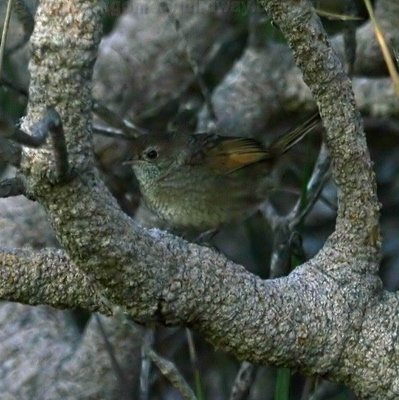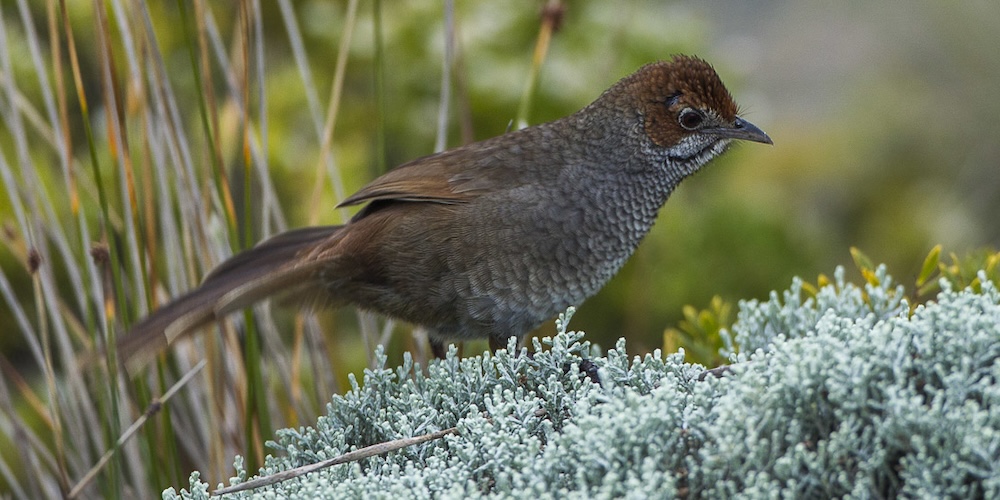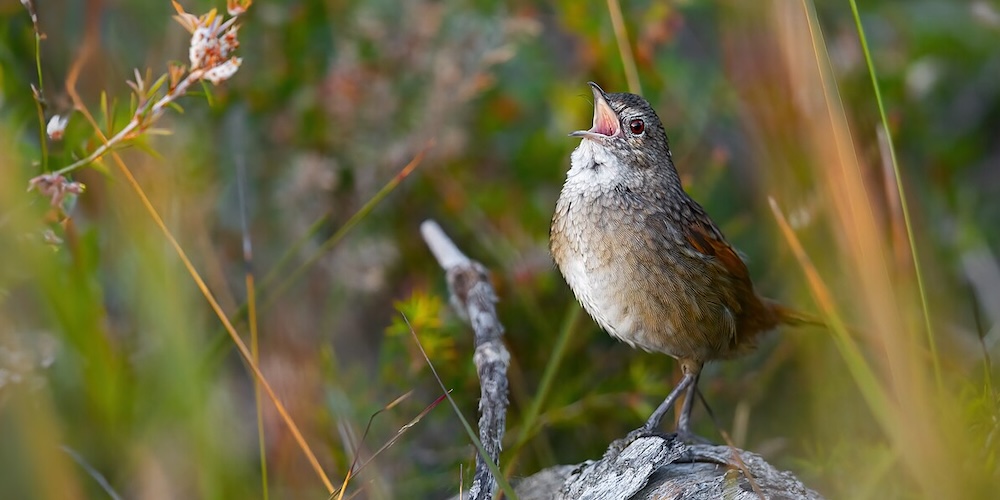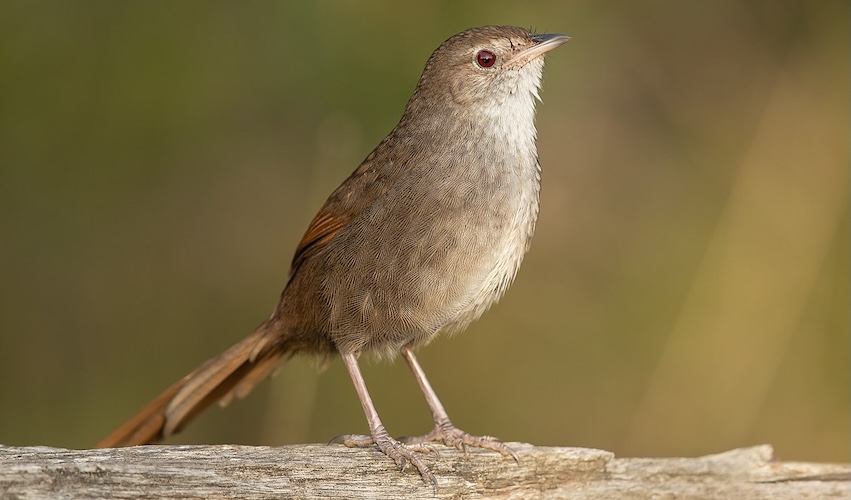Dasyornithidae – Bristlebirds

The Dasyornithidae (Bristlebirds) is a family of passerines. There are three species in the one genus – Dasyornis. The family is endemic to Australia. Previously, the genus Dasyornis was placed in the Acanthizidae or, as a subfamily, Dasyornithinae, along with the Acanthizinae and Pardalotinae, within an expanded Pardalotidae. However, it was elevated to full family level (2008), when DNA sequencing revealed that the three species were not as closely related to other Australian endemics as first thought.
Bristlebirds are long-tailed, sedentary, ground-frequenting birds. They vary in length from about 17 cm to 27 cm, with the Eastern Bristlebird being the smallest, and the Rufous Bristlebird the largest. Their colouring is mainly grey with various shades of brown, ranging from olive-brown through chestnut and rufous, on the plumage of the upperparts. The grey plumage of the underparts or the mantle is marked by pale dappling or scalloping. The common name of the family is derived from the presence of prominent rictal bristles.

Rufous Bristlebird Dasyornis broadbenti – ©Francesco Veronesi CC BY-SA 2.0 via Wikimedia Commons
They have restricted, and often reduced and disjunct, ranges along the coasts of south-western and south-eastern Australia where there is a Mediterranean climate and suitable habitat of coastal scrubs, heathlands and dense under-story vegetation in woodlands and forests. The Eastern Bristlebird occurs in threatened, localised and disjunct populations down the eastern Australian coast from south-east Queensland through New South Wales to eastern Victoria; the Rufous Bristlebird in western Victoria and southeastern South Australia, and formerly in southwestern Western Australia; with the Western Bristlebird occurring in a small area of southwest Western Australia.

Western Bristlebird Dasyornis longirostris – ©JJ Harrison CC BY-SA 4.0 via Wikimedia Commons
Bristlebirds are generally shy diurnal birds that skulk in dense vegetation. They preferentially run to avoid danger, although they are capable of flying short distances. They generally occur in pairs, but their social structure has not been studied closely. They are more usually heard than seen, although it is usually the male that sings. The song is loud, melodic and can carry for some distances. The song is thought to be territorial in nature and is often made from on top of a log or shrub to better carry through the air.

Eastern Bristlebird Dasyornis brachypterus – ©JJ Harrison CC BY-SA 4.0 via Wikimedia Commons
Most of their food is found by foraging on the ground. Birds forage in pairs, making small contact calls to keep in touch, and constantly flicking their tails whilst moving. The major part of the diet is composed of insects and seeds. Spiders, worms and other invertebrates are also taken, and birds have been observed drinking nectar as well.
Their breeding behaviour is poorly known. They are thought to mostly be monogamous and defend a territory against others of the same species. The nest is constructed by the female in low vegetation and is a large ovoid dome with a side entrance. Two dull eggs are laid. As far as is known, only the female incubates the clutch, for a period of between sixteen and twenty-one days. The nestling stage is known to be relatively long, eighteen to twenty-one days.
-
Number of bird species: 3
(As at November 2025)
According to the recently (2025) amalgamated AviList, there are just three species, in one genus in the Dasyornithidae family. They are:
Western Bristlebird Dasyornis longirostris
Eastern Bristlebird Dasyornis brachypterus
Rufous Bristlebird Dasyornis broadbenti
Given that this is a tiny family with just three species in one genus, Fatbirder provides active links below to all three species.
-
Eastern Bristlebird Dasyornis brachypterus
Species AccountSmall, long-tailed terrestrial bird of southeastern New South Wales and ranges on the Queensland border. Mottled grayish brown, paler below, with red eye. -
Eastern Bristlebird Dasyornis brachypterus
Species AccountDasyornis brachypterus is listed as Vulnerable under criteria A2bc+4bc. -
Eastern Bristlebird Dasyornis brachypterus
Species AccountSound archive and distribution map -
Rufous Bristlebird Dasyornis broadbenti
Species AccountSound archive and distribution map -
Rufous Bristlebird Dasyornis broadbenti
Species AccountA skulking red-brown bird with a long tail that has a rough uneven tip. -
Rufous Bristlebird Dasyornis broadbenti
Species AccountThe rufous bristlebird (Dasyornis broadbenti) is one of three extant species of bristlebirds. It is endemic to Australia where three subspecies have been described from coastal southwestern Western Australia, southeastern South Australia and southwestern Victoria. Its natural habitat is coastal shrublands and heathlands. It is threatened by habitat destruction. -
Rufous Bristlebird Dasyornis broadbenti
Species AccountDasyornis broadbenti is listed as Least Concern. -
Western Bristlebird Dasyornis longirostris
Species AccountSmall, long-tailed terrestrial bird of dense coastal heath in a very restricted portion of southwestern Western Australia. -
Western Bristlebird Dasyornis longirostris
Species AccountThe western bristlebird (Dasyornis longirostris) is a species of bird in the family Dasyornithidae. -
Western Bristlebird Dasyornis longirostris
Species AccountDasyornis longirostris is listed as Endangered under criteria B2ab(ii,iii,v). -
Western Bristlebird Dasyornis longirostris
Species AccountSound archive and distribution map
